Nestled by the Sea of Galilee, Tiberias is a biblical treasure trove, ripe with untold stories and ancient wisdom waiting to be explored.

Tiberias in the Bible
Like a hidden gem waiting to be discovered, the ancient city of Tiberias holds secrets you've yet to uncover. Nestled on the shores of the Sea of Galilee, it's a place where history and faith intersect in fascinating ways.
You might know it as a backdrop to several New Testament stories, but there's more to Tiberias than meets the eye. From its founding to its role in Jewish scholarship and its significance in Christian tradition, this city's legacy is as rich as it is intriguing.
Let's embark on a journey to explore the layers of history and faith that Tiberias offers, teasing at the threads of ancient wisdom and tales that have shaped the world's major religions.
Key Takeaways
- Tiberias' proximity to significant biblical sites enriches understanding of New Testament narratives.
- It served as a backdrop to several stories in the New Testament, highlighting its biblical importance.
- The city's economic vitality during Jesus' time is reflected in biblical accounts of miracles and teachings.
- Understanding Tiberias' Roman influence and societal dynamics offers insights into the challenges faced by Jesus and his ministry.
The Founding of Tiberias
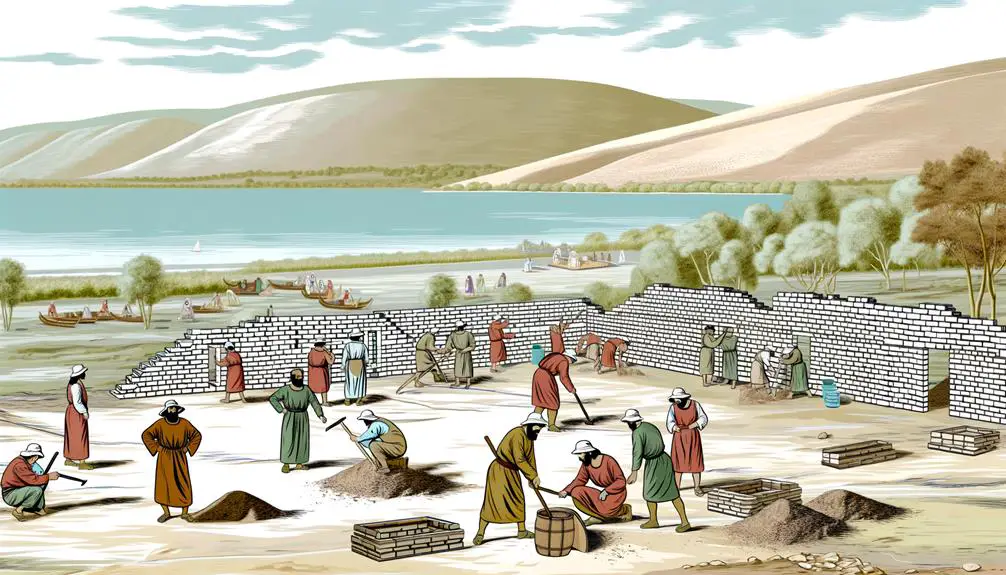
Tiberias, established by Herod Antipas around 20 AD, quickly emerged as a significant urban center on the western shore of the Sea of Galilee. You'll find that its inception wasn't merely a political maneuver but also a profound display of Roman influence and Herodian architecture. This city was designed to be a beacon of Roman culture and governance in a region steeped in Jewish traditions.
Herod Antipas, a son of Herod the Great, was deeply influenced by Roman architectural styles, which you can see in the layout and construction of Tiberias. The city's infrastructure, including its streets, public buildings, and even its water systems, showcased the Roman penchant for urban planning and engineering. Herodian architecture, known for its grandeur and attention to detail, was employed to assert the authority and cultural supremacy of the Roman Empire in this strategic location.
Moreover, Tiberias wasn't just a symbol of Roman influence. It was a practical expression of it. The city served as the administrative center of Galilee, reinforcing Roman law and order. Its founding reflected a broader strategy of Romanization, aiming to integrate distant regions into the empire through urbanization and the spread of Roman culture.
The establishment of Tiberias also marked a significant shift in the region's political landscape. By choosing to build this new city, Herod Antipas was asserting his independence and demonstrating his loyalty to Rome. This move not only secured his political future but also transformed the western shore of the Sea of Galilee into a hub of Roman administration and Herodian architectural achievement.
Tiberias During Jesus' Time

During the time of Jesus, the city of Tiberias played a pivotal role in the religious and social dynamics of the region, serving as a backdrop to many of the narratives found in the New Testament. Established under Roman auspices, it quickly became a symbol of Roman influence, a fact that didn't sit well with all Jewish factions. This tension between the Roman way of life and Jewish traditions shaped much of the societal landscape, creating a complex environment for religious teachings and interactions.
Tiberias' strategic location along the Sea of Galilee made it a hub for economic activities, further amplifying its importance during Jesus' time. Fishing, a prominent theme in the Gospels, was a cornerstone of the local economy, providing livelihoods for many, including some of Jesus' disciples. This economic vitality, underpinned by Roman infrastructure and trade networks, made Tiberias a bustling center of commerce and exchange.
As you delve deeper into the New Testament, you'll notice subtle references to the city's affluence and its juxtaposition against the humble origins of Jesus and his teachings. The Roman influence in Tiberias, while not always explicitly mentioned, sets a backdrop for understanding the societal challenges and confrontations that defined Jesus' ministry. His message of spiritual renewal and societal transformation found a particular resonance against the backdrop of Tiberias' economic prosperity and Roman cultural imprint.
Understanding Tiberias during Jesus' time offers a nuanced perspective on the New Testament narratives. It highlights the city's role in shaping the economic and social contexts in which these stories unfolded, providing a richer, more detailed understanding of the biblical era.
Jewish Scholarship in Tiberias
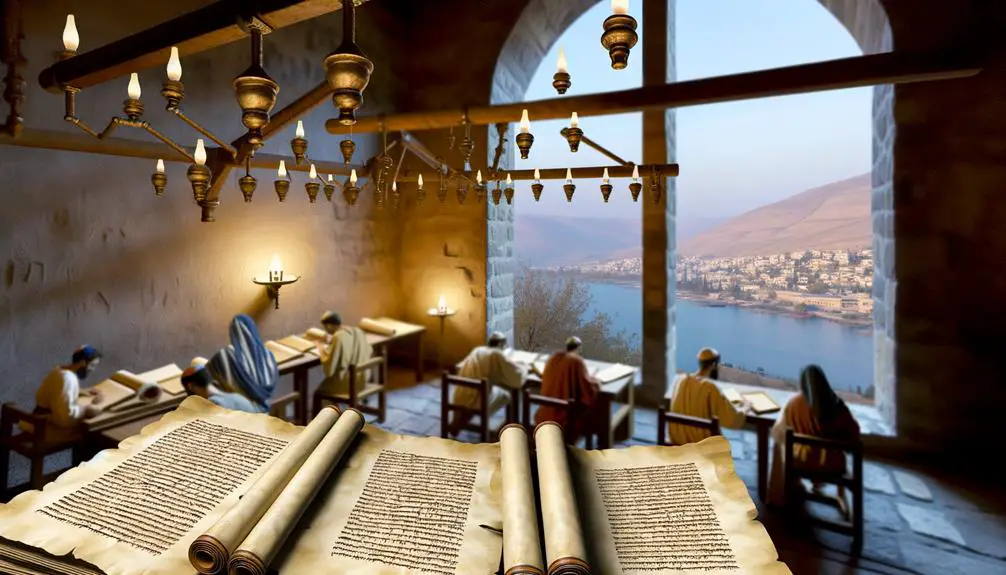
In the centuries following Jesus' era, a significant portion of Jewish scholarship flourished in Tiberias, marking it as a pivotal center for religious and intellectual pursuits. Its strategic location and the establishment of academies facilitated the development and dissemination of Jewish law and thought, significantly influencing the course of Jewish history. Tiberias' scholars were instrumental in the Mishnaic redaction, laying the groundwork for future generations and solidifying its status as a beacon of learning.
The city's contribution to Jewish scholarship extended through the establishment of Geonic academies, which preserved and interpreted Jewish texts. These academies played a crucial role in the development of Jewish law and were central to the transmission of knowledge across Jewish communities. Tiberias' intellectual climate fostered a culture of rigorous debate and inquiry, ensuring the survival and continued relevance of Jewish traditions.
To make this history more relatable, consider the following table highlighting key aspects of Jewish scholarship in Tiberias:
Aspect |
Description |
Significance |
|---|---|---|
Mishnaic Redaction |
Compilation and editing of the Mishnah |
Foundation for later Talmudic studies |
Geonic Academies |
Centers for advanced study and interpretation of Jewish law |
Preserved Jewish legal and religious texts |
Scholarly Debates |
Rigorous discussions on religious and legal matters |
Ensured the dynamism of Jewish thought |
Textual Transmission |
Copying and dissemination of texts |
Enabled widespread study and practice |
Intellectual Climate |
Environment conducive to study and discussion |
Attracted scholars, fostering innovation |
Tiberias' legacy in Jewish scholarship is profound, shaping religious practice and Jewish identity for centuries. Its academies and scholars played a vital role in the preservation and development of Jewish law, making it an enduring symbol of intellectual and spiritual achievement.
The Jerusalem Talmud and Tiberias
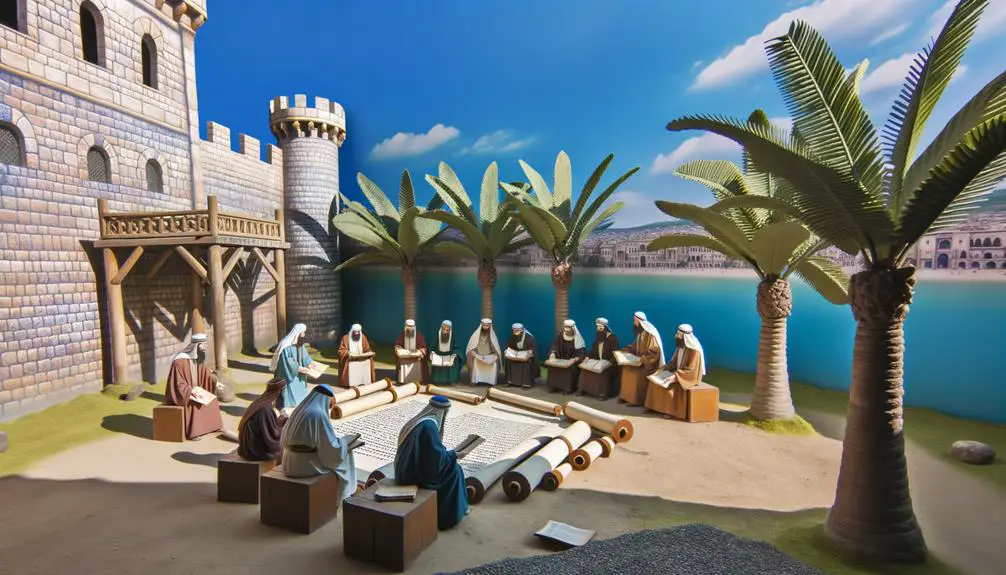
One of the most significant contributions to Jewish intellectual heritage from the city of Tiberias is the compilation of the Jerusalem Talmud, a foundational text that has deeply influenced Jewish law and philosophy. This monumental work, produced during the Amoraic period, encapsulates centuries of rabbinical discussions, legal interpretations, and ethical teachings. It's a testament to the vibrant scholarly activity that thrived in Tiberias, serving as a hub for Jewish learning and debate.
You'll find that the Jerusalem Talmud, unlike its Babylonian counterpart, offers a unique window into the practices and thoughts of the Jewish communities in the Land of Israel during the early centuries of the Common Era. Its compilation in Tiberias, specifically, underscores the city's pivotal role in preserving Jewish scholarship during times of turmoil and change. The text's structure and content reflect the dynamic nature of Amoraic debates, offering insight into the legal, social, and spiritual concerns of the period.
Moreover, as you delve deeper, the influence of the Geonic period becomes apparent. The Geonim, Jewish scholars who led the community post-Talmud, relied heavily on the Jerusalem Talmud for their rulings and teachings. Their works, many of which were penned in or around Tiberias, further cemented the city's status as a center of Jewish learning.
In essence, the Jerusalem Talmud is more than just a religious text; it's a bridge connecting past intellectuals from Tiberias to contemporary Jewish thought. Through its pages, you engage with the minds of scholars who sat in Tiberias, debating and interpreting the complexities of Jewish law and philosophy, shaping the fabric of Jewish intellectual tradition.
Tiberias in Christian Tradition
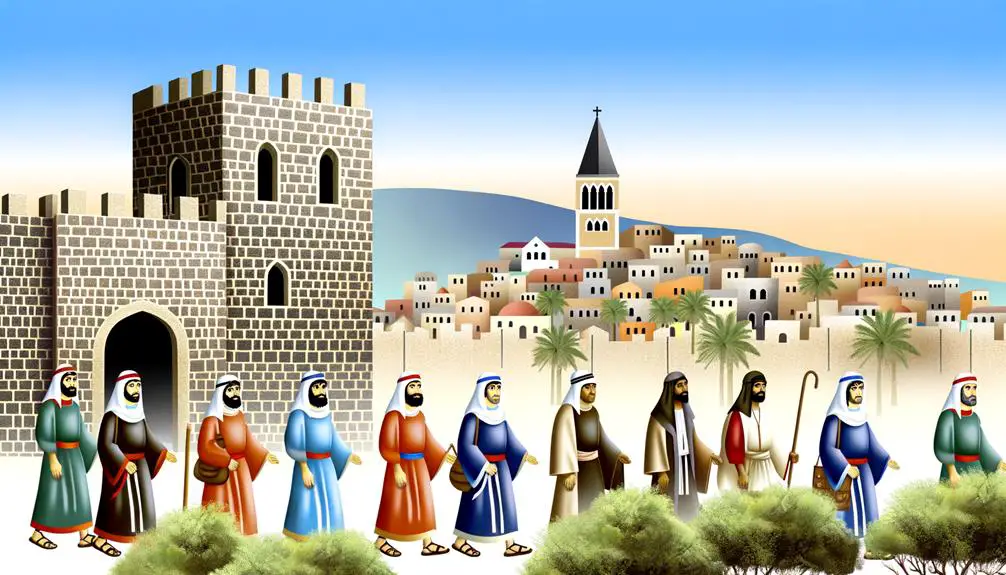
You'll find that Tiberias holds a pivotal place in Christian tradition, primarily due to the miracles Jesus performed in its vicinity. It became a focal point for early Christian pilgrimages, underscoring its deep biblical significance.
This city's rich history offers insight into the geographical and spiritual landscape that shaped the early Christian narrative.
Jesus' Miracles Near Tiberias
Near Tiberias, Jesus performed several miracles that are central to Christian tradition, showcasing his divine authority and compassion. These events, pivotal to the Galilean ministry, not only underscore his spiritual prowess but also his mastery over nature. His sea travels, integral to spreading his message, were often accompanied by miraculous occurrences that left an indelible mark on his followers and the broader narrative of Christian faith.
Miracle |
Significance |
|---|---|
Calming the stormy sea |
Demonstrated Jesus' control over nature |
Walking on water |
Symbolized his divine nature |
Feeding the 5,000 |
Showed his compassion and power to provide |
Healing the sick |
Affirmed his role as healer and messiah |
These acts, performed near Tiberias, vividly illustrate the profound impact of Jesus' ministry on early Christian tradition.
Early Christian Pilgrimages
Tiberias served as a pivotal destination for early Christian pilgrims, who journeyed to this historic locale to deepen their spiritual connection with the life and miracles of Jesus. This tradition of pilgrimage has evolved, influencing modern tourism and mapping out significant pilgrimage routes that trace the footsteps of these devout travelers.
Analyzing the impact of these early pilgrimages reveals:
- Foundation of Pilgrimage Routes: Early pilgrimages laid the groundwork for established paths that are still celebrated and followed today.
- Integration into Modern Tourism: The blend of historical reverence with tourism has enriched the travel experience, offering a multifaceted understanding of Tiberias.
- Cultural and Spiritual Continuity: These journeys ensure the continuity of a deep, spiritual narrative that connects believers across centuries, making Tiberias a timeless beacon for faith exploration.
Tiberias' Biblical Significance
Delving into the biblical significance of Tiberias, it's pivotal to note how this ancient city emerges as a crucial backdrop in Christian tradition, weaving itself into the fabric of numerous scriptural narratives.
Geographically, Modern Tiberias sits on the western shore of the Sea of Galilee, a location rich in biblical history. This proximity to significant sites of Jesus' ministry highlights Tiberias' importance in Christian tradition.
Although not directly mentioned in the Gospels, its geographical location places it near key biblical events, making it an essential point of reference for understanding the context of Jesus' teachings and miracles.
As you explore Tiberias' biblical significance, you're connecting with a city that, while subtly present, plays a foundational role in the landscape of Christian history.
Archaeological Discoveries
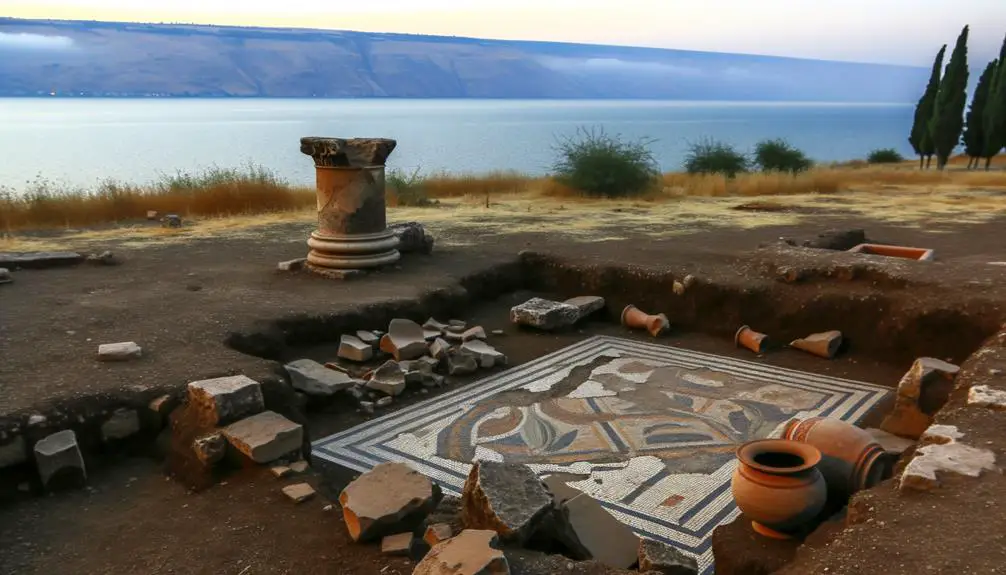
Recent excavations have unveiled significant archaeological finds, shedding light on Tiberias's biblical past and offering insights into its historical significance. These discoveries have been instrumental in understanding the extent of Roman influence in the region and the city's role in ancient trade routes.
Let's delve into some of the most compelling archaeological finds:
- Roman Architecture and Infrastructure: Excavations have uncovered well-preserved remnants of Roman architecture, including public baths, streets, and aqueducts. These structures not only underscore the Roman influence on the city's urban layout but also highlight Tiberias's strategic importance along ancient trade routes. The presence of these trade routes facilitated cultural and commercial exchanges, making Tiberias a bustling hub in its heyday.
- Ancient Inscriptions: Researchers have discovered inscriptions in various languages, including Greek, Aramaic, and Hebrew. These inscriptions provide invaluable insights into the daily lives of Tiberias's inhabitants, their beliefs, and their interactions with the ruling powers. They serve as a testament to the city's multicultural fabric and its significance as a center for religious and scholarly activity.
- Artifacts of Daily Life: The unearthing of coins, pottery, tools, and personal items has offered a glimpse into the everyday life of Tiberias's ancient population. These artifacts reveal the economic activities, dietary habits, and artistic expressions of the city's residents, painting a vivid picture of their community life.
Through these discoveries, you gain a deeper understanding of Tiberias's rich historical tapestry, which is intricately woven with threads of Roman influence and ancient trade routes. These archaeological finds not only illuminate the city's biblical significance but also its broader impact on the region's history.
Tiberias' Legacy in Faith

Reflecting on its rich history, it's clear that Tiberias has played a pivotal role in shaping religious narratives and practices throughout the centuries. As you delve into its legacy, you'll find that Modern Tiberias, while embracing its historical roots, has evolved into a vibrant city where the past and present coalesce, particularly through its cultural festivals.
Aspect |
Detail |
|---|---|
Historical Significance |
Tiberias is a testament to religious coexistence, with historical sites that are sacred to Judaism, Christianity, and Islam. |
Spiritual Heritage |
It has been a center for Jewish learning and spirituality, housing ancient synagogues and the famous Tiberias Hot Springs, believed to have healing properties. |
Modern Tiberias |
Today, it is not only a pilgrimage center but also a place where cultural festivals blend religious traditions with contemporary celebration. |
Cultural Festivals |
These festivals showcase the city's rich religious diversity, offering a platform for dialogue and understanding among faiths. |
Modern Tiberias has successfully managed to preserve its spiritual essence while adapting to the needs of a diverse, contemporary population. The city's ability to host cultural festivals that honor its religious diversity speaks volumes about its unique character. These festivals, often steeped in centuries-old traditions, offer a window into the soul of Tiberias, bridging the gap between ancient faiths and modern expressions of spirituality.
Through these gatherings, Tiberias not only commemorates its historical and religious significance but also fosters a sense of community and mutual respect among different faith groups. This dynamic interplay between the ancient and the modern underscores Tiberias' enduring legacy in faith, making it a focal point for scholars, believers, and tourists alike.
Frequently Asked Questions
How Did the Name "Tiberias" Evolve Over Time and What Were Its Earlier Names?
You're exploring how 'Tiberias' evolved over time, starting from its Roman foundation. Initially named by Herod Antipas in honor of the Emperor Tiberius, this name marked a significant shift from its earlier identities, which remain less documented.
Over centuries, 'Tiberias' underwent linguistic adaptations but its core identity, linked to Roman influence and Herod's political allegiance, remained evident. This evolution reflects broader historical and cultural shifts in the region.
Are There Any Specific Traditions or Festivals Unique to Tiberias That Have Biblical Origins?
You're exploring the layers of Tiberias, uncovering its unique blend of tradition and modernity.
While there aren't specific festivals in Tiberias directly rooted in biblical times, the city's archaeological discoveries offer a profound connection to its past.
These findings inspire modern festivals and events that, although contemporary, echo the city's ancient heritage.
These celebrations serve as a bridge, linking the present to the biblical era, offering a unique insight into Tiberias' enduring legacy.
How Did the Geography and Climate of Tiberias Influence Its Mention and Role in Biblical Stories?
You're exploring how geography and climate influenced Tiberias, focusing on agricultural practices and water sources. Its fertile lands and abundant water shaped its role, supporting diverse crops and sustaining the community.
The climate, conducive to agriculture, along with strategic water sources, played a pivotal part in its mention. These elements didn't just dictate the physical landscape but also the narrative and significance of Tiberias in historical and possibly biblical contexts.
Were There Any Significant Political Events or Conflicts in Tiberias During Biblical Times That Indirectly Shaped Its Biblical Narrative?
In a land where the Roman establishment and the Herodian dynasty sculpted the narrative, Tiberias wasn't just a backdrop; it was a stage where political dramas unfolded.
These events didn't just color the pages of history; they indirectly shaped biblical narratives, weaving complexity into the fabric of sacred texts.
You're looking at a city where every stone tells a story of power, conflict, and influence, deeply entwined with the spiritual journey of a nation.
How Has Modern Tiberias Incorporated Its Biblical Heritage Into Its City Planning, Tourism, or Educational Programs?
In modern Tiberias, you'll find the city's biblical heritage intricately woven into its urban fabric. The modern infrastructure skillfully balances historical preservation with contemporary needs, ensuring that sacred sites are accessible and highlighted.
Culinary adaptations celebrate ancient flavors with a modern twist, attracting food enthusiasts. Educational programs and tourism initiatives delve deep into the city's biblical past, making it a living classroom.
This strategic integration showcases Tiberias's rich history while catering to today's demands.
Conclusion
In essence, Tiberias isn't just a dot on the ancient map; it's a colossal beacon of faith, history, and scholarship. Its streets practically echo with the footsteps of Jesus, and its stones whisper millennia-old Talmudic secrets.
Unearthing its archaeological wonders is akin to uncovering the very heartbeat of religious traditions. Tiberias' legacy is so monumental, it transcends mere historical significance, cementing its place as an unparalleled cornerstone in the annals of faith and learning.



Sign up